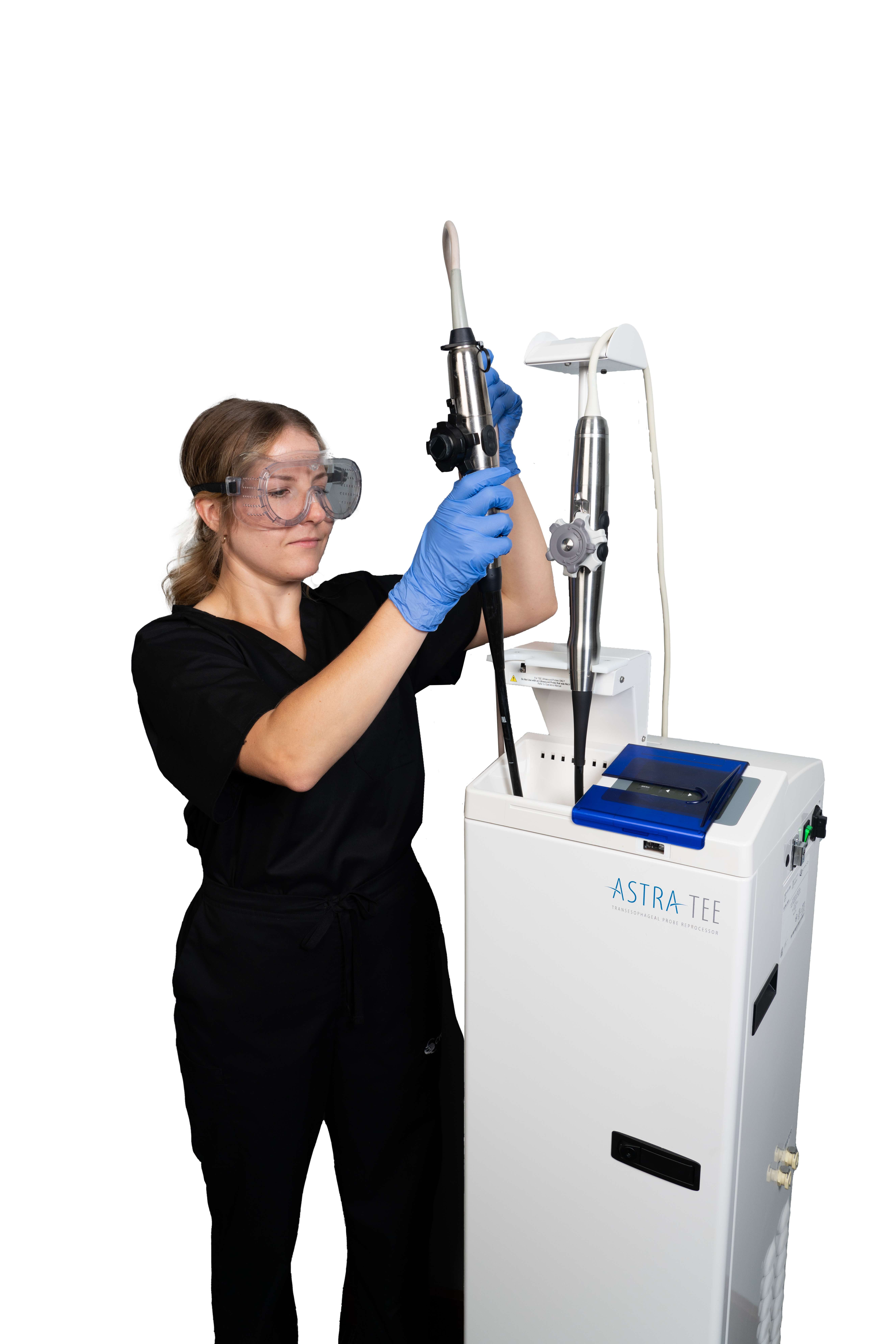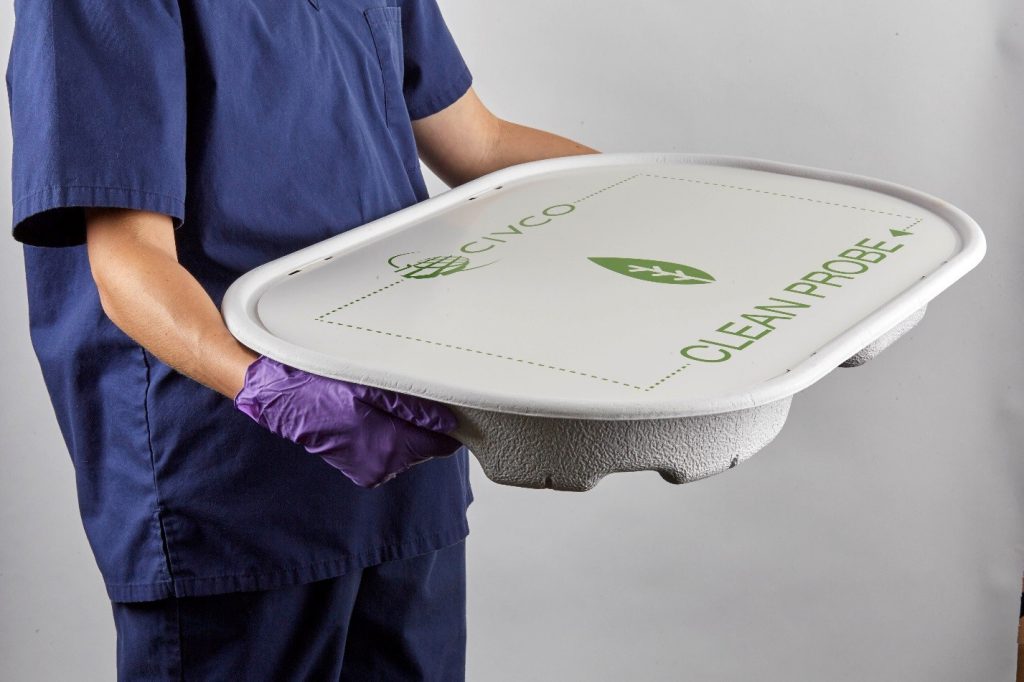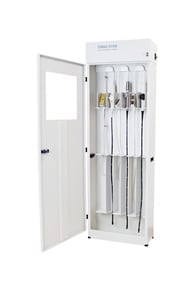The Future of Ultrasound Probe Disinfection Guidelines: The End of Manual Reprocessing?

In December 2021, the Association for the Advancement of Medical Instrumentation (AAMI) released its updated ANSI/AAMI ST91:2021, "Comprehensive guide to flexible and semi-rigid endoscope processing in health care facilities." Designed to provide guidance to staff across each stage of the flexible endoscope disinfection process, the new guidelines reflect current research and advancements with regards to scope processing. Notable updates to the standard include new classification for high-risk scopes, updated instruction for drying, storing, and handling scopes, and guidance for determining the proper length of storage (or "hang time") before reprocessing is needed.
Particularly notable is the ST91: 2021's explicit new recommendations against manual high-level disinfection of endoscopes. According to Mary Ann Drosnock, director of Clinical Affairs at Healthmark Industries and a member of AAMI's Endoscope Reprocessing Working Group, this represents a significant - but necessary - change. "We do not recommend that [sonographers] disinfect scopes manually at all," said Drosnock. "It used to be that you soaked the scope in a basin filled with disinfectant, and then you let it sit there. People thought 'longer is better,' but this creates fumes that are harmful to staff." Drosnock points to several recent peer-reviewed studies that have shown the adverse impacts that the practice may have on user health and explains that while manual disinfection is still widely utilized in outpatient and office settings, AAMI "no longer recommend(s) that in any setting." 1
These changes represent a sizable pivot in terms of what is viewed as "best" practice for achieving optimal disinfection for endoscopes. The upcoming TIR99 guideline raises pertinent questions with regards to what are considered to be the best practices for reprocessing other commonly used types of transducers, most notably transesophageal (TEE), endocavity and general purpose ultrasound probes...and what the future might hold for the disinfection of such devices.
Manual High-Level Disinfection of TEE and Ultrasound Probes: Is it Ideal?
The process of disinfecting ultrasound probes is one that, just like with endoscopes, encompasses a variety of important individual practices, including cleaning, transportation, storage, and high-level disinfection.
With regards to high-level disinfection specifically, the question of which method should be utilized - automated or manual - is no less relevant than with endoscopes. Manual disinfection of ultrasound probes typically refers to the practice of submerging probes in an HLD solution for a set amount of time, until full disinfection is achieved. While manual reprocessing remains a popular option, particularly for facilities with a low volume of procedures or budget constraints, manual disinfection also has its disadvantages - on both a practical and patient-safety level.
 \
\
When The Joint Commission released its 2016 annual summary of the "Top 10 Challenging Standards" ambulatory health care accredited organizations experienced, coming in No. 1 was standard IC.02.02.01: "The organization reduces the risk of infections associated with medical equipment, devices, and supplies." 2 3
Non-compliance with this standard is most likely due to shortcomings in reprocessing, says Phenelle Segal, RN, CIC, FAPIC , president and founder of Infection Control Consulting Services, a national consulting firm based in Delray Beach, Fla.
"There is a combination of factors that result in non-compliance with respect to reprocessing," Segal says. She notes that these include the following:
- Failure to follow manufacturer instructions for use (IFU)
- Inconsistent practices
- Increased workload for reprocessing department
- Staff turnover
- Lack of formal training and education 4
All too often, these shortcomings - nearly all of which are frequently directly tied to manual reprocessing of transducers - can lead to serious repercussions and result in a delayed or flawed disinfection process for probes. Common concerns regularly associated with manual reprocessing include:
- Longer disinfection processes
- Restrictive staff workflow
- Lack of standardization
- Increased exposure of staff to high-level disinfectants
- Potential damage to probes
Automated Disinfection: A Different Method of Disinfection:
Thankfully, there is an alternative option to manual reprocessing available to healthcare workers: automated disinfection.
A method of disinfection that has grown in popularity over the last 20 years, "automated high-level disinfection" refers to the process of performing high-level disinfection on ultrasound transducers via the use of an automated reprocessing system, and has been shown to improve patient and operator safety by preventing exposure to toxic chemicals, while also reducing the risk of operator error. Automated disinfection is also designed to help with employee compliance, as there is no need to "babysit the probe," which can take time away from patient care; it can also save on potential damage to the transducer due to over-soaking in the potent chemicals. Ultimately, automated disinfection systems can help to standardize disinfection processes, improve staff workflow, and meet compliance standards - the sum of which improve patient and staff safety.
As technology advances, so too do the ways that healthcare facilities seek to both streamline and improve their disinfection processes - a trend that looks set to become only more pronounced in the the future, particularly as increasingly more hospitals begin to integrate automated reprocessors into their workflows. In her 2014 article "Evaluation of an automated high-level disinfection technology for ultrasound transducers," Karen Vickery concluded that automated reprocessors "offer an alternative to manual ultrasound probe disinfection technologies," and that such devices "reduce the risks of operator error and can improve patient and operator safety by preventing exposure to toxic chemicals. The adoption of next-generation disinfection devices may help to decrease infection risk and improve patient safety." 5
ECRI reinforces these benefits in their 2018 guidelines "Cleaning and Disinfecting Diagnostic Ultrasound Transducers: Our Recommendations," stating that automated disinfection presents "an acceptable alternative to the manual method for HLD," and that "these systems offer several potential advantages over manual HLD, including:
- They are easier to use.
- There is no risk of spilling HLD solutions.
- They eliminate fumes that are toxic to staff and the environment.
- Disinfecting fumes are shortened.
- Disinfection efficacy is improved." 6
Additionally, SDMS also recommends the use of automated systems for probe disinfection in their "Guidelines for Infection Prevention and Control in Sonographer: Reprocessing the Ultrasound Transducer," published in 2020, stating outright that "automated processes are preferable due to the reduced risk of operator error." 7
With more and more healthcare facilities adapting automatic reprocessors into their disinfection workflows - as well as an increasingly growing number of associations recommending automated disinfection as a viable alternative to manual methods - one might wonder: what does the future look like for automated reprocessing as a method of disinfecting TEE, transvaginal and transrectal ultrasound probes? Will it remain a popular approach to probe disinfection? And will manual disinfection continue to be as widely utilized in the face of these increasing technological advancements?
AAMI's TIR99: Paving the Future
While there are no concrete answers yet, there are a few potential indicators on the horizon that will likely serve to shine some light on the issue. One such indicator is the upcoming release of AAMI's new TIR99 guidelines, which are expected to outline updated proper steps and guidance for processing dilators and transesophageal/ultrasound probes in healthcare facilities. Like the ST91:2021's relevance on endoscope reprocessing, the TIR99's recommendations for reprocessing TEE and ultrasound probes will almost certainly play a large role in determining the approach that many healthcare facilities take when disinfecting their transducers.
Ultimately, automated reprocessing is a method of disinfection that offers several substantial benefits to healthcare facilities. However, for many healthcare workers eager to integrate these automated methods into their disinfection processes, it can also, unfortunately, be hard to know exactly which processors to consider.

Introducing ASTRA
CIVCO's ASTRA series of reprocessors received their FDA 510K clearance in March 2016 and took ultrasound disinfection to the next level of innovation. In June 2017, CIVCO expanded system compatibility to include both OPA (Cidex OPA and Metricide OPA) and hydrogen peroxide (Revital-Ox RESERT) high-level disinfectants. They are the only automated ultrasound reprocessors able to disinfect up to two probes simultaneously. The ASTRA VR disinfects and rinses one or two endovaginal or endorectal probes, while the ASTRA TEE disinfects and rinses one or two transesophageal probes.
Automated Logging
The ASTRA systems utilize built-in barcode technology to capture and store disinfection data. They automatically capture probe information, operator ID, temperature, date and time of disinfection, minimum required concentration (MRC) pass or fail, electrical leakage test pass or fail and cycle outcome. All data from approximately the last 1500 cycles is stored on the ASTRA and downloaded via a USB port as needed.
Lower Cycle Costs
In addition, the ASTRA systems do not use proprietary disinfectants, which drive down cycle cost significantly.
In short, the ASTRA series of ultrasound probe reprocessors:
- Help to meet Joint Commission standards
- Generate very low operating costs.
- Use hydrogen peroxide and OPA, not Glutaraldehyde
- Disinfect one or two probes at a time
- Utilize a built-in barcode reader for data logging
- Automate the entire disinfection log process.
- Automate the tracking of consumables
The Process of Disinfection:
Of course, high-level disinfection is just one aspect of the disinfection process for TEE and ultrasound probes. Other important practices include:
- Cleaning: Defined by the CDC as "the removal of foreign material (e.g. soil, and organic
material) from objects," cleaning is typically conducted prior to high-level disinfection, and plays a critical
role against preventing the accumulation of bioburden. Bioburden is defined as "the degree of microbial
contamination or microbial load; the number of microorganisms contaminating an object," which - when left
unchecked - can result in the formation of communities of microorganisms known as biofilm, attaching themselves
to the surface of the probe and effectively developing a barrier that interferes with the antimicrobial activity
of disinfectant solutions. 8
AIUM recommends the following with regards to ultrasound probe cleaning: "Transducers should be cleaned after each examination with soap and water or quaternary ammonium (a low-level disinfectant) sprays or wipes. The transducers must be disconnected from the ultrasound scanner for anything more than wiping or spray cleaning. After removal of the transducer cover (when applicable), use running water to remove any residual gel or debris from the transducer. Use a damp gauze pad or other soft cloth and a small amount of mild non-abrasive liquid soap (household dishwashing liquid is ideal) to thoroughly cleanse the transducer. Consider the use of a small brush, especially for crevices and areas of angulation, depending on the design of the particular transducer. Rinse the transducer thoroughly with running water, and then dry the transducer with a soft cloth or paper towel." 9

- Transport: The importance of transport in the reprocessing of TEE and ultrasound probes is often woefully under-looked in many facilities. Even when thorough attention is paid to the rest of the ultrasound probe cleaning and disinfection process (bedside clean, pre-clean, high-level disinfection, storage), a non-compliant daily transport process leaves open the possibility of recontamination, jeopardizing the integrity of the entire workflow. There are many existing national guidelines and standards that discuss daily transport of medical devices such as semi-critical ultrasound probes:
-
- The Joint Commission: "remove the device from the room in a covered container." 10
- ANSI/AAMI 2013: "The type of container that should be used depends on the items being transported. Bins with lids, enclosed or covered carts, rigid sterilization containers, and impermeable bags are among the types of containers that may be used." 11
- AORN: "Use a closed container or closed cart...Label with biohazard label...Transport in a horizontal position, not suspended." 12
CIVCO's TEE Probe Transport Tray helps you to maintain compliance with national transport standards and OEM guidelines. Made of recyclable water-resistant material, the TEE Probe Transport Tray's reversible clean/dirty lid helps to simplify your workflow, allowing for a safe probe transport that reduces the risk of damage to the probe, while also preventing cross-contamination.
Storage: When it comes to properly storing TEE and ultrasound probes post-high-level disinfection, it's important to ensure that disinfected transducers remain uncontaminated. There are a variety of reputable guidelines for helping to ensure adequate storage post-procedure, with two of the most notable being:
- The Joint Commission: AMMI (ST91 2015) states that with regards to semi-critical devices (including TEE and ultrasound probes), transducers "should be hung vertically with the distal tip hanging freely in a well-ventilated, clean area." They also recommend storing probes "in a manner that will protect them from damage or contamination."13
- SDMS' "Guidelines for Infection Prevention and Control in Sonography: Reprocessing the Ultrasound Transducers" suggests that "proper storage reduces the risk of re-contamination of the transducer from environmental contaminants or accidental contamination," and recommends that users "clearly label the container holding the transducer with disinfection level, storage date, and maximum storage duration ." SDMS also suggests "[maintaining] distinct separation of clean and dirty transducers," stating that "dirty transducers should not be placed in the same cabinet as clean transducers." 7
CIVCO's Ultrasound Probe Storage System provides a safe and clean storage environment for your disinfected ultrasound probes, complete with a HEPA filtration system that provides continuous airflow using positive pressure, as well as a locking door for added security for your delicate transducers. To learn more, click here.
It's About Achieving the Best Disinfection Possible For Your Transducers
Maintaining a thorough disinfection process for your TEE and ultrasound probes is - and will always be - a critically important component in keeping your patients safe. High-level disinfection, cleaning, transport, and storage are all aspects of that process, with each playing vital roles in ensuring the integrity of your transducers.
Bottom line: it's important that you, as a healthcare worker, take steps to ensure that each one of these processes are implemented in the best and most effective manner. By following current guidelines, keeping an eye on future advancements, and implementing changes as necessary, you help to both safeguard your patients and ensure a bright future for your probe disinfection.
References
- St91: extensive updates for endoscope cleaning patient safety. (2022). Journal of Clinical Engineering 69-71. https://doi.org/10.1097/JCE.0000000000000517
- The Joint Commission. 2016 Top 10 Challenging Standards-Elements of Performance for Health Centers
- Joint Commission Quick Safety Sheet. Improperly sterilized or HLD equipment - a growing problem
- Improving Reprocessing Compliance: 5 Steps to Take.
- Vickery K. Gorgis V. Z. Burdach J. & Patel D. (2014). Evaluation of an automated high-level disinfection technology for ultrasound transducers. Journal of Infection and Public Health 153-60. https://doi.org/10.1016/j.jiph.2013.09.008
- Cleaning and Disinfecting Diagnostic Ultrasound Transducers: Our Recommendations.
- Guidelines for infection prevention and control in sonography: reprocessing the ultrasound transducer. (2020). Journal of Diagnostic Medical Sonography 381-403. https://doi.org/10.1177/8756479320933256
- Guideline for Disinfection and Sterilization in Healthcare Facilities, 2008.
- Guidelines for Cleaning and Preparing External- and Internal-Use Ultrasound Transducers and Equipment Between Patients as well as Safe Handling and Use of Ultrasound Coupling Gel
- The Joint Commission. Infection Preventoin and Control (IC)(Hospital and Hospital Clinics/Hospitals). Self-Contained high Level Disinfection Units - Semi-Critical Devices
- ANSI/AAMI ST58:2013 (R2018). Chemical Sterilization And High-Level Disinfection In Health Care Facilities
- The Guideline for Processing Flexible Endoscopes.
- The Joint Commission. Disinfection and Sterilization: Dispelling the Myths.






